Pollination
Table of Contents
What is Pollination?
Pollination is a method where pollen grains are picked from an anther, which is the male part of a flower and transferred to the flower’s female part called the stigma, where seeds are produced.
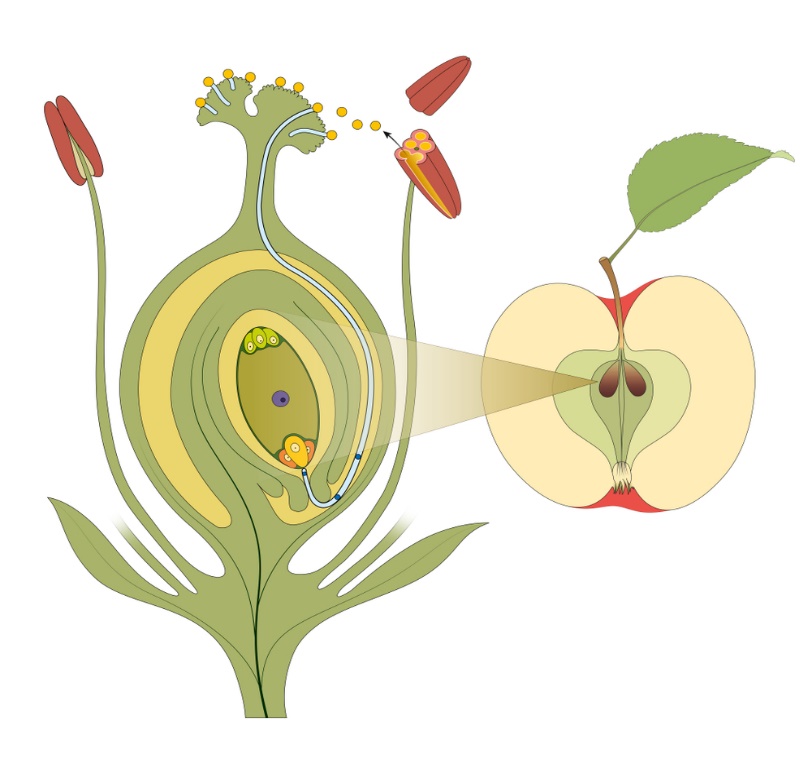
Cleistogamous flower are bisexual flowers which never open and pollination occurs in the closed flower.
The chasmogamous flowers are open with their anther and stigma exposed for pollination.
In these flowers two types of pollinations take place:
- Self-Pollination
- Cross Pollination
Self-Pollination
Self-pollination occurs when both the anther and the stigma mature simultaneously and come in contact with each other.
Autogamy is self-formation which occurs between anther and stigma of the same flower.
- In self- pollination, there is no involvement of external factors like wind, water, and other pollinating agents.
- Self-pollination ensures that even a smaller quantity of produced pollen grains from plants have a good success rate in pollination.
- The purity of the race is maintained, as there is no diversity in the genes.
Cross-Pollination
This type of pollination occurs in self-incompatible plants. In this, the anther and the stigma mature at different times so cannot come in contact with each other. Cross-pollination is of two types:
- Geitonogamy
- Xenogamy
Cross-Pollination(Geitonogamy)– When the pollen grains from the anther transfer to the stigma of a different flower in the same plant, it is known as geitonogamy. It is seen in monoecious plants like maize. It is a cross pollination within the same plant. In this, pollens are transferred by insects or winds.
Cross-Pollination(Xenogamy)– When the pollen grains from the anther of a flower get transferred to the stigma of a flower in different plant, it is known as xenogamy. This process carries genetically different pollen to the stigma. e.g., papaya, maize.
Cross Pollination method leads to an increase in genetic diversity as different flowers will share and combine their genetic information to create unique offspring.
- Cross-pollination introduces new genes into a sequence of species, and this is mainly due to the fertilization between genetically different gametes.
- The recessive characters in the lineage are eliminated because of genetic recombination.
- It helps improve the immunity towards diseases.
Types of Cross-Pollination
The process of cross-pollination requires the help of biotic and abiotic agents like animals, birds, wind, insects, water and other agents as pollinators.
Zoophily
Pollination by Animals (Zoophily): Animals help in seed dispersal by eating the fruits of plants and the seeds get disposed through their waste and germinate in a new place where they are transferred.
Anthropophilly
Artificial method of pollination is performed by spreading pollen grains over the female flowers. Artificial pollination is done by humans, and it is called Anthropophilly.
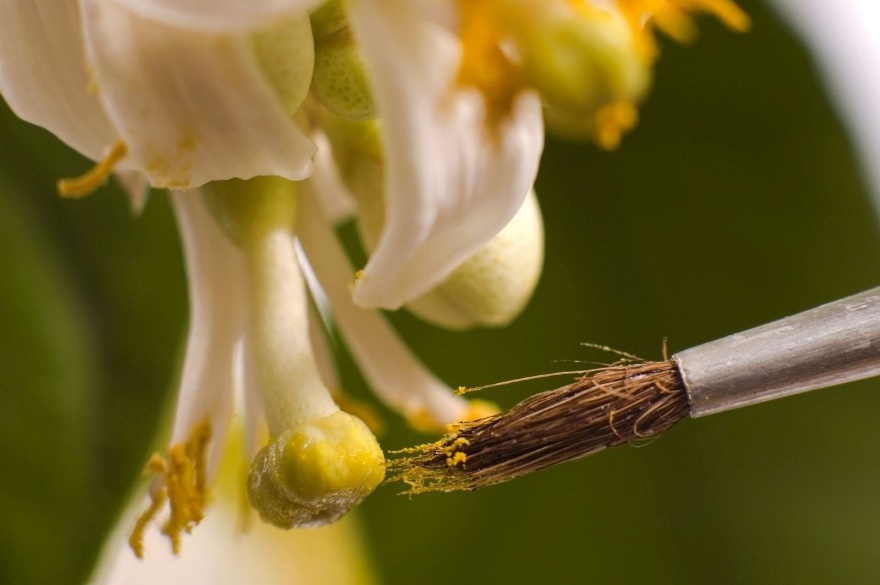
Hydrophily
Pollination by Water –Hydrophily – A few aquatic plants have their flowers growing in the air. They are pollinated by the insects. Other plants that have their flowers submerged in water release their pollen in the water that drifts in the water and are caught by the feathery stigma of female flowers.
The two methods are:
- Surface Pollination
- Submerged Pollination
Surface Pollination
As the name implies, the pollens float on the surface of the water and reach the stigmas of the female flowers. Water Thyme (Hydrilla), Ditch Grasses (Ruppia), Waterweeds (Elodea) and Water Starwort (Callitriche) are notable examples where this method of pollination is observed. In plants such as Eelgrass (Vallisneria), the male flowers detach from the plant and float on the surface of the water, passively flowing and coming in contact with the female flower’s stigmas.
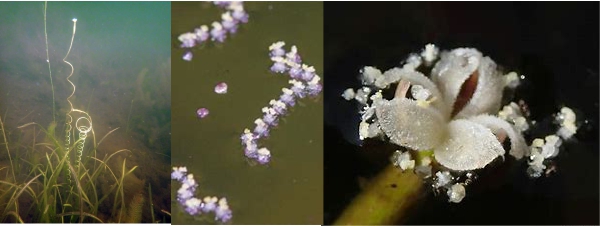
Vallisneria (Fig above: Male flower bursts inside water, floats and reaches female flower)
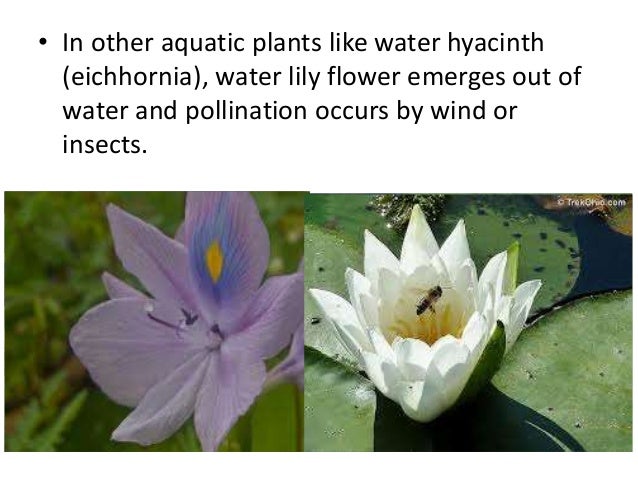
Submerged Pollination
Submerged pollination occurs if the pollen grain
is heavier than water – where it sinks down and is caught by the stigmas of female flowers. This form of pollination is seen in plants like the water-nymphs (Najas).
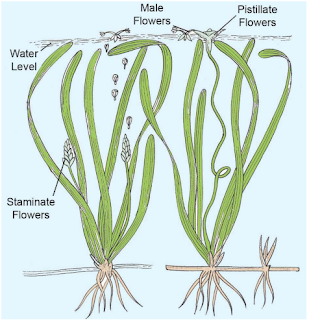
Ornithophily
Bird pollinated plants (Ornithophily):
The bird pollinated flowers have funnel –shaped or tubular corollas which are brightly coloured.
The floral parts are commonly leathery, and they produce copious amount of nectar and large quantities of pollen which are sticky.
Most bird-pollinated flowers are red and have a lot of nectar. They also tend to be unscented.
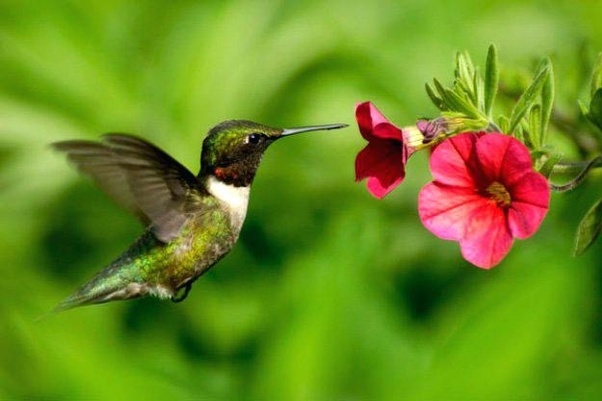
Chiropterophily
Bat pollinated plants (chiropterophily): The pollination of plants by bats is called chiropterophily.
Bats generally pollinate plants that bloom at night. They are attracted to large, white or pale-coloured blooms measuring 1 to 3 ½ inches in diameter.
Bats like nectar-rich, highly fragrant blooms with a musty, fruity aroma. Flowers are usually tube- or funnel-shaped.
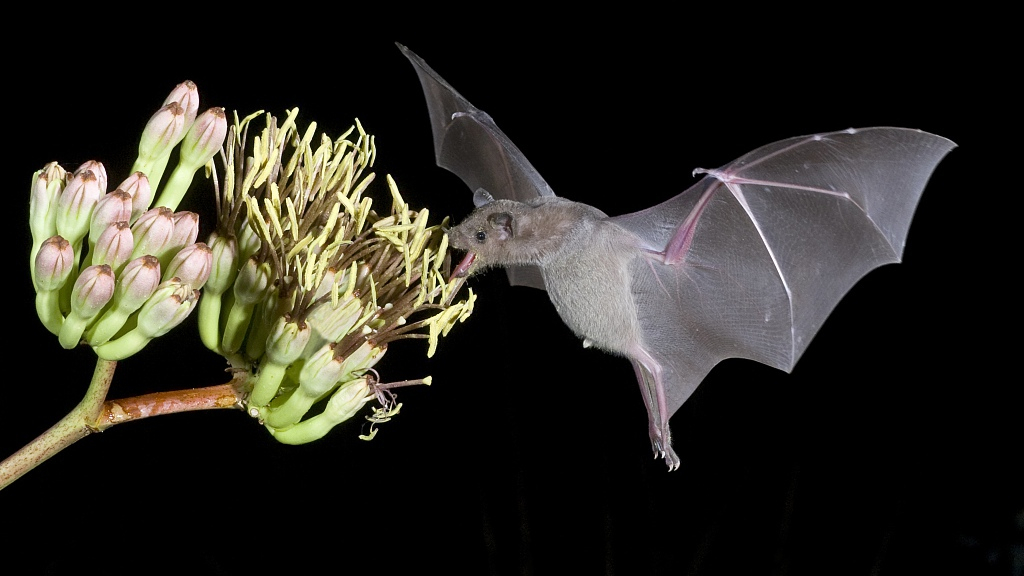
Anemophily
Wind pollinated plants (Anemophily):
Wind pollinated plants are those that rely on wind to transfer pollen from the male reproductive organs (anthers) to the female reproductive organs (stigma) of flowers.
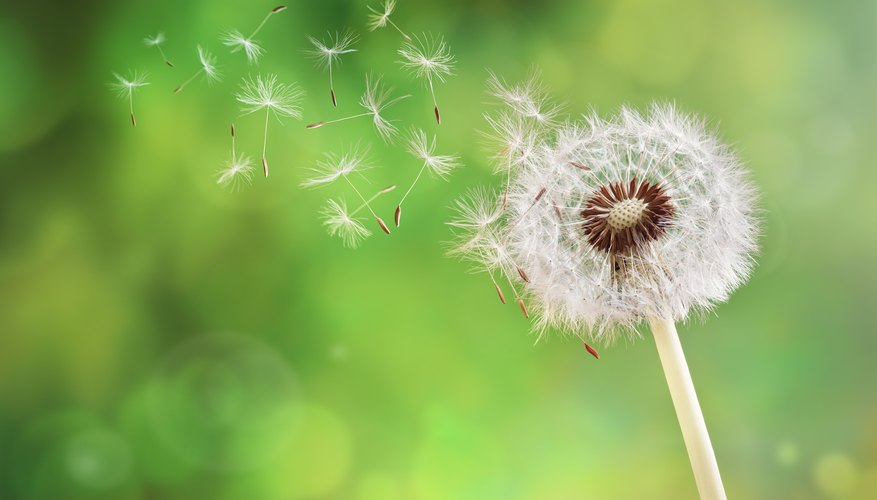
These plants release billions of pollen grains into the air so that a lucky few will hit their targets on other plants. The stigma is often sticky and large to attract the pollen grains to it.
Features: Wind-pollinated flowers are usually green or dull-coloured and lack the sepals, sepals and nectar that most flowers have.
These include wheat, rice, corn, rye, barley, and oats. Coconut, palm, maize, grasses and all gymnosperms are the best examples of wind-pollinated plants.
Entomophily
Insect pollinated plants (Entomophily):
Insect-pollinated plants rely on insects, birds, and animals to transfer pollen grains from the anther of one flower to the stigma of another.
Examples of insect-pollinated flowers include sunflowers, orchids, and buddleia.
Insect-pollinated flowers are usually large with brightly coloured petals . The pollen grains in insect-pollinated flowers are larger, sticky, and spiky to aid in transportation by the pollinator.
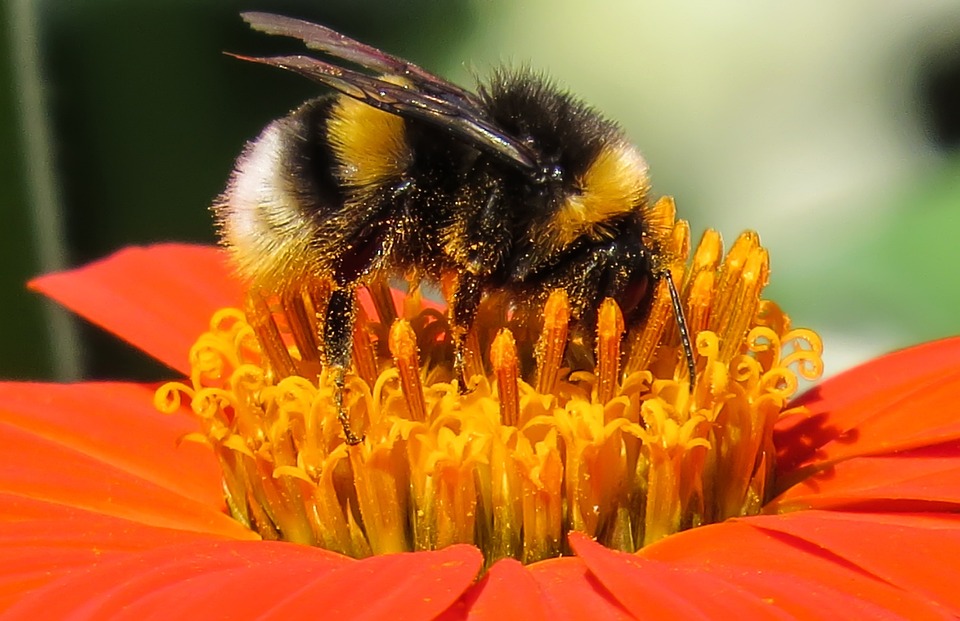
Take Quiz
1. The transfer of pollen grains from anthers of one flower to stigma another flower of either the same or genetically similar plant.
(a) geitonogamy
(b) autogamy
(c) cleistogamy
(d) allogamy
ANSWER
(a) geitonogamy
2. Cleistogamous flower are
(a) Male flower which never open
(b) female flowers which never open
(c) bisexual flowers which never open
(d) open bisexual flowers which performs self pollination in bud condition
ANSWER
(c) bisexual flowers which never open
3. Ornithophily is pollination by
(a) humans
(b) wind
(c) birds
(d) bat
ANSWER
(c) birds
4. Phenomenon of pollen grains being transferred to stigma by air is called
(a) anemophily
(b) entomophily
(c) zoophily
(d) malacophily
ANSWER
(a) anemophily
5. In chiropterophily, pollination is performed by
(a) bats
(b) birds
(c) squirrels
(d) insects
ANSWER
(a) bats
6. The type of pollination that brings genetically different types of pollen grain to the stigma of a plant is called
(a) xenogamy
(b) geitonogamy
(c) chasmogamy
(d) autogamy
ANSWER
(a) xenogamy
7. Geitonogamy involves:
(a) fertilization of a flower by the pollen from another flower of the same plant.
(b) fertilization of a flower by the pollen from the same flower.
(c) fertilization of a flower by the pollen from a flower of another plant in the same population.
(d) fertilization of a flower by the pollen from a flower of another plant belonging to a distant population.
ANSWER
(a) fertilization of a flower by the pollen from another flower of the same plant.
8. Match List I with List II.
| List I (Interacting species) | List II (Name of interaction) | ||
| A | Maize(Zea) | 1 | Hydrophilous |
| B | Snapdragon(Antirrhinum) | 2 | Chiropterophilous |
| C | Silk cotton(Salmalia) | 3 | Entomophilous |
| D | Vallisneria | 4 | Anemophilous |
| 5 | Ornithophilous |
Choose the correct answer from the options given below
1) A-4, B-5, C-2, D-1
2) A-4, B-3, C-5, D-1
3) A-2, B-3, C-5, D-4
4) A-3, B-1, C-2, D-4
ANSWER
1) A-4, B-5, C-2, D-1
9. A dioecious flowering plant prevents both
(a) Cliestogamy and Xenogamy
(b) Autogamy and Xenogamy
(c)Autogamy and geitonogamy
(d) Geitonogamy and Xenogamy
ANSWER
(c) Autogamy and geitonogamy
Autogamy is pollination by transfer of pollen grains from the anther of a flower to the stigma of the same flower.
Geitonogamy is pollination by transfer of pollen grains from the anther of a flower to the stigma of another flower of the same plant.
A plant having unisexual flowers is said to be dioecious. Such a flower will neither exhibit autogamy nor geitonogamy.
10. Which of the following statements is not correct?
(a) Insects that consume pollen or nectar without bringing about pollination are called pollen/nectar robbers.
(b) Pollen germination and pollen tube growth are regulated by chemical components of pollen interacting with those of the pistil
(c) Some reptiles have also been reported as pollinators in some plant species
(d) Pollen grains of many species can germinate on the stigma of a flower, but only one pollen tube of the same species grow into the style
ANSWER
(d) is incorrect
Other species’ pollen grains are incompatible and do not germinate on the stigma of a flower of a different species.
A style can be formed by several pollen tubes of the same species.
additional info: Malacophily refers to snail pollination, whereas ophiophily refers to snake pollination.
